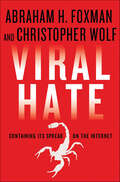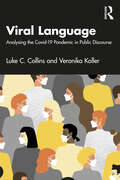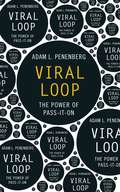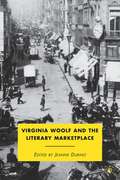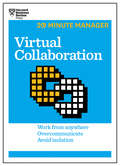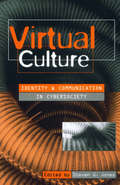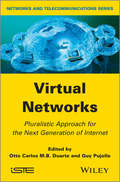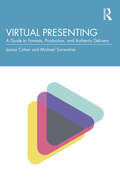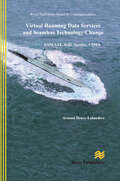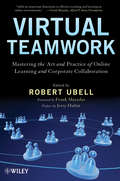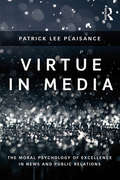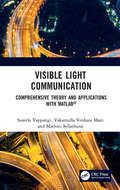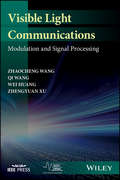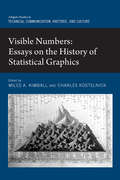- Table View
- List View
Viral Hate: Containing Its Spread on the Internet
by Christopher Wolf Abraham H. FoxmanEmboldened by anonymity, individuals and organizations from both left and right are freely spewing hateful vitriol on the Internet without worrying about repercussions.Lies, bullying, conspiracy theories, bigoted and racist rants, and calls for violence targeting the most vulnerable circulate openly on the web.And thanks to the guarantees of the First Amendment and the borderless nature of the Internet,governing bodies are largely helpless to control this massive assault on human dignity and safety. Abe Foxman and Christopher Wolf expose the threat that this unregulated flow of bigotry poses to the world.They explore how social media companies like Facebook and YouTube, as well as search engine giant Google, are struggling to reconcile the demands of business with freedom of speech and the disturbing threat posed by today's purveyors of hate. And they explain the best tools available to citizens, parents, educators, law enforcement officers, and policy makers toprotect thetwin values of transparency and responsibility. As Foxman and Wolf show, only an aroused and engaged citizenry can stop the hate contagion before it spirals out of control - with potentially disastrous results.
Viral Language: Analysing the Covid-19 Pandemic in Public Discourse
by Veronika Koller Luke C. CollinsViral Language considers a range of different types of public communication and their discussion of the Covid-19 pandemic as a way to investigate health communication. The authors introduce and apply a range of approaches informed by linguistic theory to investigate experiences of the pandemic across a variety of public contexts. In doing so, they demonstrate how experiences of health and illness can be shaped by political messaging, scientific research, news articles and advertising. Through a series of case studies of Covid-related texts, the authors consider aspects of language instruction, information and innovation, showcasing the breadth of topics that can be studied as part of health communication. Furthermore, each case study provides practical guidance on how to carry out investigations using social media texts, how to analyse metaphor, how to track language innovation and how to work with text and images. Viral Language is critical reading for postgraduate and upper undergraduate students of applied linguistics and health communication.
Viral Loop: The Power Of Pass-it-on
by Adam PenenbergYou read a book, you recommend it to a friend. That friend tells another friend. And another... until the book becomes this year's word-of-mouth sensation. This is the first to analyze the power of the 'pass-it-on' phenomenon, introducing us to the architects of the mightily efficient, money-spinning model known as the Viral Loop - the secret behind some of the most successful businesses in recent history. Outfits such as Google, eBay, Flickr and Facebook all employ the model at their core; all have seen their stock valuations skyrocket within years of forming. The genius lies in the model's reliance on replication: what's the point of using Facebook if none of your friends can see your profile, or using Flickr if you can't share your photos? Where's the joy in posting a video on YouTube if no one watches it? In creating a viral product that people want, need and desire, growth can, and will, take care of itself. Find out why the Loop will catch us all up, sooner rather than later...
Virgin Crossing Borders: Feminist Resistance and Solidarity in Translation (Transformations: Womanist studies)
by Emek ErgunThe Turkish-language release of Hanne Blank’s Virgin: The Untouched History is a politically engaged translation aimed at disrupting Turkey’s heteropatriarchal virginity codes. In Virgin Crossing Borders, Emek Ergun maps how she crafted her rendering of the text and draws on her experience and the book’s impact to investigate the interventionist power of feminist translation. Ergun’s comparative framework reveals translation’s potential to facilitate cross-border flows of feminist theories, empower feminist interventions, connect feminist activists across differences and divides, and forge transnational feminist solidarities. As she considers hopeful and woeful pictures of border crossings, Ergun invites readers to revise their views of translation’s role in transnational feminism and examine their own potential as ethically and politically responsible agents willing to search for new meanings. Sophisticated and compelling, Virgin Crossing Borders reveals translation’s vital role in exchanges of feminist theories, stories, and knowledge.
Virginia Woolf and the Literary Marketplace
by Jeanne DubinoThese unique essays focus primarily on Woolf's non-fiction and considers her in the context of the modernist marketplace. With research based on new archival material, this volume makes important new contributions to the study of the 'gift economy. '
Virginia Woolf and the Migrations of Language
by Emily DalgarnoVirginia Woolf's rich and imaginative use of language was partly a result of her keen interest in foreign literatures and languages - mainly Greek and French, but also Russian, German and Italian. As a translator she naturally addressed herself both to contemporary standards of translation within the university, but also to readers like herself. In Three Guineas she ranged herself among German scholars who used Antigone to critique European politics of the 1930s. Orlando outwits the censors with a strategy that focuses on Proust's untranslatable word. The Waves and The Years show her looking ahead to the problems of postcolonial society, where translation crosses borders. In this first in-depth study of Woolf and European languages and literatures, Emily Dalgarno opens up a rewarding new way of reading her prose.
Virginia Woolf, Literary Materiality, and Feminist Aesthetics: From Pen to Print (Material Modernisms)
by Amber JenkinsThis book interrogates the relationship between the material conditions of Woolf's writing practices and her work as a printer and publisher at the Hogarth Press. In bringing to light her embodied literary processes, from drafting and composition to hand-printing and binding, this study foregrounds the interactions between Woolf's modernist experimentation and the visual and material aspects of her printed works. By drawing on the field of print culture, as well as the materialist turn in Woolf scholarship, it explores how her experience in print, book-design and publishing underlines her experimental writing, and how her literary texts are conditioned by the context of their production. This book, therefore, provides new ways of reading Woolf's modernism in the context of twentieth-century print, material, and visual cultures. By suggesting that Woolf's work at the Hogarth Press sensitized her to the significant role the visual aspects of a text play in its system of representation, it also considers the extent to which materiality informs both her work, as well as her engagement with Bloomsbury formalist aesthetics, which often exaggerate the distinction between visual and verbal modes of expression.
Virtual Collaboration (HBR 20-Minute Manager Series)
by Harvard Business ReviewWorking remotely gives you flexibility and independence. But it can pose challenges when you need to team up with colleagues or coworkers. Virtual Collaboration covers the basics of working productively-and collaboratively-from anywhere. You'll learn to: Communicate clearly over a variety of media Bond with colleagues across the wires Keep others-and yourself-accountable Avoid and mitigate tech glitchesDon't have much time? Get up to speed fast on the most essential business skills with HBR's 20-Minute Manager series. Whether you need a crash course or a brief refresher, each book in the series is a concise, practical primer that will help you brush up on a key management topic. Advice you can quickly read and apply, for ambitious professionals and aspiring executives-from the most trusted source in business. Also available as an ebook.
Virtual Culture: Identity and Communication in Cybersociety
by Steven JonesVirtual Culture marks a significant intervention in the current debate about access and control in cybersociety exposing the ways in which the Internet and other computer-mediated communication technologies are being used by disadvantaged and marginal groups - such as gay men, women, fan communities and the homeless - for social and political change. The contributors to this book apply a range of theoretical perspecitves derived from communication studies, sociology and anthropology to demonstrate the theoretical and practical possibilities for cybersociety as an identity-structured space.
Virtual Freedoms, Terrorism and the Law (Routledge-Giappichelli Studies in Law)
by Giovanna De MinicoThis book examines the risks to freedom of expression, particularly in relation to the internet, as a result of regulation introduced in response to terrorist threats. The work explores the challenges of maintaining security in the fight against traditional terrorism while protecting fundamental freedoms, particularly online freedom of expression. The topics discussed include the clash between freedom of speech and national security; the multijurisdictional nature of the internet and the implications for national sovereignty and transnational legal structures; how to determine legitimate and illegitimate association online; and the implications for privacy and data protection. The book presents a theoretical analysis combined with empirical research to demonstrate the difficulty of combatting internet use by terror organizations or individuals and the range of remedies that might be drawn from national and international law. The work will be essential reading for students, researchers and policy makers in the areas of Constitutional law; Criminal Law, European and International law, Information and Technology law and Security Studies.
Virtual Homelands: Indian Immigrants and Online Cultures in the United States
by Madhavi MallapragadaThe internet has transformed the idea of home for Indians and Indian Americans. In Virtual Homelands: Indian Immigrants and Online Cultures in the United States, Madhavi Mallapragada analyzes home pages and other online communities organized by diasporic and immigrant Indians from the late 1990s through the social media period. Engaging the shifting aspects of belonging, immigrant politics, and cultural citizenship by linking the home page, household, and homeland as key sites, Mallapragada illuminates the contours of belonging and reveals how Indian American struggles over it trace back to the web's active mediation in representing, negotiating, and reimagining "home." As Mallapragada shows, ideologies around family and citizenship shift to fit the transnational contexts of the online world and immigration. At the same time, the tactical use of the home page to make gender, racial, and class struggles visible and create new modes for belonging implicates the web within complex political and cultural terrain. On e-commerce, community, and activist sites, the recasting of home and homeland online points to intrusion by public agents such as the state, the law, and immigration systems in the domestic, the private, and the familial. Mallapragada reveals that the home page may mobilize to reproduce conservative narratives of Indian immigrants' familial and citizenship cultures, but the reach of a website extends beyond the textual and discursive to encompass the institutions shaping it, as the web unmakes and remakes ideas of "India" and "America."
Virtual Networks: Pluralistic Approach for the Next Generation of Internet
by Guy Pujolle Otto Carlos M.B. DuarteThe first chapter of this title concerns virtualization techniques that allow sharing computational resources basically, slicing a real computational environment into virtual computational environments that are isolated from one another. The Xen and OpenFlow virtualization platforms are then presented in Chapter 2 and a performance analysis of both is provided. This chapter also defines the primitives that the network virtualization infrastructure must provide for allowing the piloting plane to manage virtual network elements. Following this, interfaces for system management of the two platforms are proposed in Chapter 3. To control and manage virtual network elements, five primitives that the network virtualization infrastructure must provide are defined: instantiate, delete, migrate, monitor and set. The book then moves on to survey existing control algorithms for virtual networking. It also describes the main challenges for packet forwarding using Xen as a virtualization tool and describes, in more detail, a proposal for local control of virtual networks. Within each physical node, this proposal guarantees the service level acquired by each virtual network, even in the presence of misbehaving virtual networks. Contents 1. Virtualization, Luís Henrique M.K. Costa. 2. Virtual Network Interfaces, Miguel Elias M. Campista. 3. Performance Improvement and Control of Virtual Network Elements, Igor M. Moraes. 4. State of the Art in Context-Aware Technologies, Edmundo R.M. Madeira and Guy Pujolle. 5. Providing Isolation and Quality-of-Service to Virtual Networks, Miguel Elias M. Campista. 6. Piloting System, Edmundo R.M. Madeira and Nelson Luis S. Da Fonseca. 7. Management and Control: The Situated View, Otto Carlos M.B. Duarte. 8. System Architecture Design, Otto Carlos M.B. Duarte. About the Authors Otto Carlos M.B. Duarte is Full Professor at Universidade Federal do Rio de Janeiro in Brazil, where he has worked since 1978. His research interests include mobile communications, security, multicast, and QoS guarantees. Guy Pujolle is currently Professor at University Pierre and Marie Curie (Paris VI) in France and a member of the Scientific Advisory Board of Orange/France Telecom Group. He has published widely in the area of computer systems modeling and performance, queuing theory, high-speed networks, intelligence in networking, wireless networks, and Post-IP networks, including 19 influential texts and monographs in these areas.
Virtual Presenting: A Guide to Formats, Production and Authentic Delivery
by Jamie Cohen Michael SorrentinoResponding to the widespread and continued acceleration of virtual working practices in recent years, Virtual Presenting provides a clear guide to producing, presenting, and broadcasting in a remote context. Unlike traditional studio production where a presenter is surrounded by a crew and cameras, the virtual presenter is often isolated or connected to a remote crew. Virtual Presenting explains how to make an authentic connection across great spaces, linked only via the Internet. Topics covered include how to build a virtual setup; how to appear on camera; how to appear confident and comfortable; and how to optimize your presentation voice. The authors demonstrate how to tell effective stories across the entire new media landscape of webcasting, webinars, livestreams, and virtual events. Finally, success stories and case studies from teachers, students, and professionals are interwoven to show how these guidelines translate into best practices. Virtual Presenting will be a valuable resource for students of media production and remote broadcasting as well as professionals looking to become stronger communicators and visual presenters.
Virtual Roaming Data Services and Seamless Technology Change: GSM, LTE, WiFi, Satellite, CDMA
by Arnaud Henry-LabordèreThe subject is “Virtual Roaming for data services” and “Seamless Technology change” also called “Number Continuity”.“Virtual Roaming for voice and SMS” was covered in one of the author's previous book. “Virtual Roaming” means that it allows a subscriber to visit a network which his home network does not have an agreement with. The “Seamless Technology change” allows a user to keep all his services including reception of calls and SMS sent to his usual number when he switches his GSM to a Satellite phone or to WiFi. The implementation of Seamless Technology change uses the SS7 Roaming Hub and GTP Hubs technology explained in the first part of the book. The book also contains chapters explaining in detail the steering and anti-steering of roaming, LTE Serving Mobile Location Centers, and Advanced Policy and Charging implementations in LTE and 3G. This is to be used as an easy reference book. All the relevant references to the standards are included chapter by chapter. This is the first book on the two main subjects of Virtual Data Roaming and Seamless Technology change. Keywords:Virtual Roaming, Number Continuity, Seamless technology change, Policy Charging and Control, LTE LBS, Steering of Roaming, GTP Hub, MMS Hub,RADIUS Hub, DIAMETER Hub
Virtual Taste and Smell Technologies for Multisensory Internet and Virtual Reality
by Adrian David Cheok Kasun KarunanayakaCurrently, Internet and virtual reality communication is essentially audio-visual. The next important breakthrough of the Internet will be the communication and sharing of smell and taste experiences digitally. Audio-visual stimuli are frequency based, and they can be easily digitized and actuated. On the other hand, taste and smell stimuli are based on chemical molecules, therefore, they are not easy to digitize or actuate. To solve this problem, we are required to discover new digital actuation technologies for taste and smell. The authors of this book have experimented on developing digital actuation devices for several years. This book will provide a complete overview of the importance of digitizing taste and smell, prior works, proposed technologies by the authors, other state of the art research, advantages and limitations of the proposed methods, and future applications. We expect digital taste and smell technologies will revolutionize the field of multisensory augmented reality and open up new interaction possibilities in different disciplines such as Human Computer Interaction, Communication, and Augmented and Virtual Reality.
Virtual Teamwork: Mastering the Art and Practice of Online Learning and Corporate Collaboration
by Jerry Hultin"This book, by Robert Ubell and his excellent team of collaborators, adds an important dimension to effective teaching and learning in online environments. It addresses how interaction and collaboration online can be effectively harnessed in virtual teams. It is an important contribution to the larger field of Internet-based education." —Frank Mayadas, Alfred P. Sloan Foundation How to create and manage highly successful teams online With the advent of the global economy and high-speed Internet, online collaboration is fast becoming the norm in education and industry. This book takes online collaboration to the next level, showing how you can bolster online learning and business performance with the innovative use of virtual teams. Written by a team of experts headed by online learning pioneer Robert Ubell, Virtual Teamwork covers best practices for online instruction and team learning, reveals proven techniques for managing enterprise and global virtual teams, and helps you choose the best communication tools for the job. Educators, project managers, and anyone involved in teaching online courses or creating online programs will find a wealth of tips and techniques for building and managing successful virtual teams, including guidance for: Integrating team instruction in the virtual classroom Using best techniques for team interaction across borders and time zones Structuring cost-effective, competitive projects that work Leveraging leadership, mentoring, and conflict management in virtual teams Conducting testing, grading, and peer- and self-assessment online Managing corporate, global, and engineering virtual teams Choosing the right technologies for effective collaboration
Virtual Worlds and Criminality
by Dieter Hermann Kai Cornelius, LL.M.The fusion between virtuality and reality has created a new quality of experience establishing metaverses and virtual worlds. Second Life, Twinity, Entropia Universe or Fregger have experienced rapid growth in recent years and show no signs of slowing down. Not only have countless companies discovered these "virtureal worlds" as marketplaces, but so have fraudsters and other criminals. In this book, European experts from different academic disciplines show how to meet the new challenges arising from virtual worlds. They discuss the reasons for and the impacts of these new forms of criminality as well as the necessity and means of combating them. Moreover, other fundamental issues are examined, such as the addictive potential of virtual-world use, media violence, and conflict resolution problems arising in the context of virtual worlds.
Virtualization of Universities
by Thomas PfefferThe purpose of this volume is to shape conceptual tools to understand the impact of new information and communication technologies (ICTs) on the organization of universities. Traditional research-based universities, the most typical representatives of the higher education system, find themselves challenged by the speed and the wide range of technical innovations, but also by a vast array of implicit assumptions and explicit promises associated with the distribution of digital media. The author observes that as universities increasingly use digital media (computers and the Internet) to accomplish their tasks, a transformation takes place in an evolutionary rather than in a revolutionary way. Using the University of Klagenfurt as an in-depth case study, he explores such dynamic issues as how digital media affect the practice of research, the preservation and dissemination of knowledge (for example, through publishing and archiving), and delivery of education at universities. More broadly, he considers issues of organizational culture and design, administration, and leadership as universities integrate digital technologies into all aspects of their operations.
Virtue Ethics and Professional Journalism
by Aaron QuinnThis book examines the moral role of news media practitioners and organizations, and applies a modified philosophical account of Virtue Ethics as a framework for the role of journalists—and journalism organizations—in public life. It shows how journalists and news organizations that adopt an aim towards professional excellence (virtue) by putting a premium on investigative journalism—with both large and small measures depending on the nature of the reporting—can achieve lofty professional goals under modern deadlines. The news media, both electronic and traditional, are imperative to an informed public, and an informed public is critical to a properly functioning cross-section of social, government and corporate domains. The book emphasizes the virtues of justice and integrity as foundational to professional practice. It examines the modern ethical challenges presented by organizations ranging from online upstarts to massive media conglomerates, each that have economic challenges that can inhibit professional excellence through corruption or corrosion. The author applies his account of virtue—bolstered by suggestions for complementary reforms in education and regulation—to improve an ethically challenged industry as it undergoes significant technological change.
Virtue in Media: The Moral Psychology of Excellence in News and Public Relations
by Patrick Lee PlaisanceThis work establishes a contemporary profile of virtue in professional media practice. Author Patrick Lee Plaisance examines the experiences, perspectives, moral stances, and demographic data of two dozen professional exemplars in journalism and public relations. Plaisance conducted extensive personal "life story" interviews and collected survey data to assess the exemplars’ personality traits, ethical ideologies, moral reasoning skills and perceived workplace climate. The chosen professionals span the geographic United States, and include Pulitzer Prize winners and trendsetting PR corporate executives, ranging from rising stars to established veterans. Their thoughts, opinions, and experiences provide readers with an insider’s perspective on the thought process of decision makers in media. The unique observations in this volume will be stimulating reading for practitioners, researchers, and students in journalism and public relations. Virtue in Media establishes a key benchmark, and sets an agenda for future research into the moral psychology of media professionals.
Visible Light Communication
by Shlomi ArnonVisible light communication (VLC) is an evolving communication technology for short-range applications. Exploiting recent advances in the development of high-power visible-light emitting LEDs, VLC offers an energy-efficient, clean alternative to RF technology, enabling the development of optical wireless communication systems that make use of existing lighting infrastructure. Drawing on the expertise of leading researchers from across the world, this concise book sets out the theoretical principles of VLC, and outlines key applications of this cutting-edge technology. Providing insight into modulation techniques, positioning and communication, synchronisation, and industry standards, as well as techniques for improving network performance, this is an invaluable resource for graduate students and researchers in the fields of visible light communication, optical wireless communication, and industrial practitioners in the field of telecommunications.
Visible Light Communication: Comprehensive Theory and Applications with MATLAB®
by Mathini Sellathurai Suseela Vappangi Vakamulla Venkata ManiThe field of visible light communication (VLC) has diverse applications to the end user including streaming audio, video, high-speed data browsing, voice over internet and online gaming. This comprehensive textbook discusses fundamental aspects, research activities and modulation techniques in the field of VLC. Visible Light Communication: A Comprehensive Theory and Applications with MATLAB® discusses topics including line of sight (LOS) propagation model, non-line of sight (NLOS) propagation model, carrier less amplitude and phase modulation, multiple-input-multiple-output (MIMO), non-linearities of optical sources, orthogonal frequency-division multiple access, non-orthogonal multiple access and single-carrier frequency-division multiple access in depth. Primarily written for senior undergraduate and graduate students in the field of electronics and communication engineering for courses on optical wireless communication and VLC, this book: Provides up-to-date literature in the field of VLC Presents MATLAB codes and simulations to help readers understand simulations Discusses applications of VLC in enabling vehicle to vehicle (V2V) communication Covers topics including radio frequency (RF) based wireless communications and VLC Presents modulation formats along with the derivations of probability of error expressions pertaining to different variants of optical OFDM
Visible Light Communications: Modulation and Signal Processing (IEEE Series on Digital & Mobile Communication)
by Zhaocheng Wang Wei Huang Qi Wang Zhengyuan XuA complete and comprehensive reference on modulation and signal processing for visible light communication This informative new book on state-of-the-art visible light communication (VLC) provides, for the first time, a systematical and advanced treatment of modulation and signal processing for VLC. Visible Light Communications: Modulation and Signal Processing offers a practical guide to designing VLC, linking academic research with commercial applications. In recent years, VLC has attracted attention from academia and industry since it has many advantages over the traditional radio frequency, including wide unregulated bandwidth, high security, and low cost. It is a promising complementary technique in 5G and beyond wireless communications, especially in indoor applications. However, lighting constraints have not been fully considered in the open literature when considering VLC system design, and its importance has been underestimated. That’s why this book—written by a team of experts with both academic research experience and industrial development experience in the field—is so welcome. To help readers understand the theory and design of VLC systems, the book: Details many modern techniques on both modulation and signal processing aspects Links academic research with commercial applications in visible light communications as well as other wireless communication systems Combines theoretical rigor with practical examples in presenting optical camera communication systems Visible Light Communications: Modulation and Signal Processing serves as a useful tool and reference book for visible light communication professionals, as well as wireless communication system professionals and project managers. It is also an important guide for undergraduates and graduates who want to conduct research in areas of wireless communications.
Visible Numbers: Essays on the History of Statistical Graphics
by Charles KostelnickBringing together scholars from around the world, this collection examines many of the historical developments in making data visible through charts, graphs, thematic maps, and now interactive displays. Today, we are used to seeing data portrayed in a dizzying array of graphic forms. Virtually any quantified knowledge, from social and physical science to engineering and medicine, as well as business, government, or personal activity, has been visualized. Yet the methods of making data visible are relatively new innovations, most stemming from eighteenth- and nineteenth-century innovations that arose as a logical response to a growing desire to quantify everything-from science, economics, and industry to population, health, and crime. Innovators such as Playfair, Alexander von Humboldt, Heinrich Berghaus, John Snow, Florence Nightingale, Francis Galton, and Charles Minard began to develop graphical methods to make data and their relations more visible. In the twentieth century, data design became both increasingly specialized within new and existing disciplines-science, engineering, social science, and medicine-and at the same time became further democratized, with new forms that make statistical, business, and government data more accessible to the public. At the close of the twentieth century and the beginning of the twenty-first, an explosion in interactive digital data design has exponentially increased our access to data. The contributors analyze this fascinating history through a variety of critical approaches, including visual rhetoric, visual culture, genre theory, and fully contextualized historical scholarship.
Visions of Infamy: The Untold Story of How Journalist Hector C. Bywater Devised the Plans that Led to Pearl Harbor
by William H. HonanJapanese Admiral Isoroku Yamamoto smashed the American fleet at Pearl Harbor on Dec. 7, 1941, yet the man who first conceived of the Pacific war -- Japan's surprise attack, the seizure of the Philippines and Guam, and the American island-hopping campaign -- was a British naval correspondent, Hector C. Bywater. He wrote a series of brilliant books and articles in the 1920s and 1930s that prophetically outlined naval strategies that would read like a blueprint for the Pacific Theater during World War II. Bywater's ideas created an uproar and then were quickly forgotten. But Yamamoto adopted Bywater's ideas as his own.
